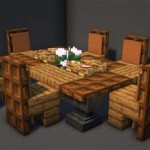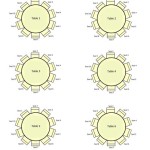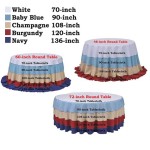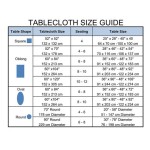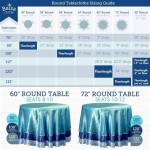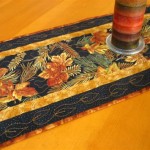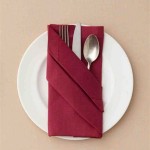How To Use a Plastic Tablecloth As Backdrop In Weddings and Events
Plastic tablecloths, often perceived as utilitarian items for picnics and casual gatherings, can surprisingly transform into versatile and cost-effective backdrops for weddings and events. Their affordability, availability in various colors and textures, and ease of manipulation make them a creative solution for event decorators and budget-conscious individuals seeking impactful visual elements. While traditionally used to protect tables, the application of plastic tablecloths extends far beyond their original intent, offering a wide range of decorative possibilities, especially when repurposed as backdrops.
The use of plastic tablecloths as backdrops requires careful planning and execution to achieve a polished and professional look. Unlike traditional fabric backdrops, plastic tablecloths present unique challenges and opportunities. Understanding the material's properties, including its tendency to wrinkle, reflect light, and tear, is crucial in selecting appropriate techniques for installation and design. Thoughtful consideration of color palettes, draping styles, and supplementary decorative elements is also essential to elevate the backdrop from a simple plastic sheet to a visually stunning focal point.
Furthermore, the method of attachment significantly impacts the overall appearance and stability of the backdrop. Improperly secured plastic tablecloths can sag, tear, or create an uneven surface, detracting from the intended aesthetic. Choosing the right adhesives, hanging mechanisms, and support structures is paramount to ensuring a secure and visually appealing backdrop that withstands the duration of the event. This article will delve into the techniques, considerations, and creative applications involved in utilizing plastic tablecloths as backdrops for weddings and events.
Selecting the Right Plastic Tablecloths
The selection of appropriate plastic tablecloths is the foundation of a successful backdrop. Not all plastic tablecloths are created equal, and variations in material thickness, finish, and color intensity directly influence the final result. Thicker, heavier-gauge plastic tablecloths generally offer greater durability and resistance to tearing, making them ideal for backdrops that require extensive draping or are exposed to high-traffic areas. Thinner tablecloths, while more delicate, can be suitable for creating layered effects or intricate designs where weight is a concern.
The finish of the plastic tablecloth impacts its light-reflecting properties. Glossy or metallic tablecloths can create a vibrant and eye-catching backdrop, but they also tend to amplify imperfections and wrinkles. Matte or textured tablecloths, on the other hand, offer a more subtle and refined look, minimizing glare and concealing minor flaws. The choice of finish should align with the overall aesthetic of the event and the desired level of luminosity.
Color selection is equally crucial in setting the ambiance and complementing the event's theme. Plastic tablecloths are available in a vast array of colors, ranging from classic neutrals to bold and vibrant hues. Consider the existing color scheme of the venue, the lighting conditions, and the desired mood when choosing the color palette for the backdrop. Neutral colors, such as white, ivory, or beige, provide a versatile foundation that can be easily customized with accents of other colors. Bold colors, such as red, blue, or green, can create a dramatic and impactful statement, but they should be used judiciously to avoid overwhelming the space.
Patterns, while less common in plastic tablecloths intended for backdrops, can add visual interest and texture. Geometric patterns, floral motifs, or abstract designs can be incorporated to enhance the overall aesthetic. However, intricate patterns can be distracting or clash with other decorative elements, so careful consideration is necessary when choosing patterned tablecloths. Ultimately, the selection of plastic tablecloths should be based on a combination of factors, including durability, finish, color, and pattern, to ensure a visually appealing and structurally sound backdrop.
Techniques for Hanging and Securing the Backdrop
Properly hanging and securing the plastic tablecloth backdrop is essential for achieving a professional and stable result. The method of attachment depends on the available support structure, the size and weight of the backdrop, and the desired aesthetic. Several techniques can be employed, each with its own advantages and disadvantages.
One common method involves using adhesive hooks or clips specifically designed for hanging lightweight materials. These hooks can be attached to walls, ceilings, or existing structures, providing a secure anchor point for the plastic tablecloth. However, it is crucial to select hooks with sufficient adhesive strength to support the weight of the material, especially when using multiple tablecloths or incorporating additional decorative elements. Prior testing on an inconspicuous area is recommended to ensure that the adhesive does not damage the surface upon removal.
Alternatively, a backdrop stand or frame can provide a stable and versatile support structure. These stands typically consist of adjustable vertical poles and horizontal crossbars, allowing for customization of the backdrop's height and width. Plastic tablecloths can be draped over the crossbar and secured with clamps, clothespins, or fabric ties. This method offers greater flexibility in terms of design and allows for easy adjustments to the backdrop's position and orientation. However, backdrop stands may require additional space and may not be suitable for all venues.
For outdoor events, securing the backdrop against wind and weather is particularly important. In addition to using strong adhesives or clamps, consider weighting down the bottom edge of the tablecloth with sandbags, rocks, or other heavy objects. This will prevent the backdrop from billowing or tearing in windy conditions. Furthermore, choose a location that is sheltered from direct sunlight and rain to minimize the risk of damage to the plastic tablecloth. Regardless of the chosen method, ensure that the backdrop is securely fastened and free from wrinkles or sagging. A well-secured backdrop not only enhances the visual appeal of the event but also prevents accidents and ensures the safety of guests.
Creative Design Ideas and Embellishments
Beyond the practical aspects of selection and installation, creative design ideas and embellishments can elevate a plastic tablecloth backdrop from a simple covering to a stunning visual centerpiece. The versatility of plastic tablecloths allows for a wide range of decorative possibilities, limited only by imagination and creativity.
One popular technique involves layering multiple tablecloths in different colors and textures to create depth and dimension. For example, a base layer of white or ivory can be overlaid with sheer or metallic tablecloths to add shimmer and visual interest. The layers can be arranged in a variety of patterns, such as horizontal stripes, vertical columns, or cascading drapes, to achieve a desired effect. Experimenting with different combinations of colors and textures can result in unique and visually striking backdrops.
Another creative approach involves incorporating lighting to enhance the backdrop's ambiance. String lights, fairy lights, or LED strip lights can be draped behind or around the tablecloth to create a soft and romantic glow. The color and intensity of the lights can be adjusted to match the event's theme and create a desired mood. Uplighting, which involves placing lights at the base of the backdrop and directing them upwards, can also add dramatic flair and highlight the texture and folds of the plastic tablecloth.
Furthermore, embellishments such as flowers, ribbons, balloons, or fabric swags can be added to the backdrop to enhance its visual appeal. Fresh or artificial flowers can be attached to the tablecloth using adhesive dots or floral wire to create a floral wall or garland. Ribbons in complementary colors can be draped across the backdrop to add texture and movement. Balloons can be arranged in clusters or arches to create a festive and celebratory atmosphere. The key is to choose embellishments that complement the overall design and enhance the aesthetic of the event.
Consider the event's theme and purpose when designing the backdrop. For weddings, a romantic and elegant design with soft colors and delicate embellishments may be appropriate. For corporate events, a more professional and polished design with clean lines and minimalist embellishments may be preferred. By carefully considering the design elements and incorporating creative embellishments, a plastic tablecloth backdrop can be transformed into a visually stunning focal point that enhances the overall ambiance of the event.
In addition to the larger design elements, attention to detail is crucial in achieving a polished and professional look. Ensure that the edges of the tablecloths are neatly trimmed and that any wrinkles or creases are smoothed out. Use a steamer or iron on a low setting to remove stubborn wrinkles, being careful not to melt or damage the plastic. Consider adding a border or frame around the backdrop to define its edges and create a more finished appearance. By paying attention to these details, one can elevate a plastic tablecloth backdrop from a simple DIY project to a sophisticated and elegant design element.
Finally, remember that creativity and innovation are key to unlocking the full potential of plastic tablecloths as backdrops. Don't be afraid to experiment with different techniques, materials, and embellishments to create a unique and personalized design that reflects the event's theme and style. With careful planning, attention to detail, and a touch of imagination, a plastic tablecloth can be transformed into a stunning and memorable backdrop that enhances the overall ambiance of any wedding or event.

Diy Plastic Tablecloth Backdrop With Curtain Rods

How To Make An Easy Diy Party Backdrop

Diy Party Background For 5 Or Less

Photo Booth Backdrop Makoodle

D I Y Photo Booth Backdrop For 10 The Thinking Closet

Photo Booth Backdrop Using Plastic Tablecloths Monica Lerma

D I Y Photo Booth Backdrop For 10 The Thinking Closet
How To Make An Easy Diy Party Backdrop

D I Y Photo Booth Backdrop For 10 The Thinking Closet
How To Make An Easy Diy Party Backdrop
Related Posts

